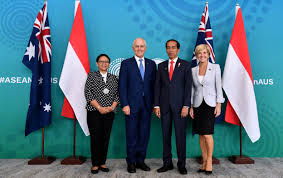AUSTRALIA’S ROLE IN INDONESIA'S INFRASTRUCTURE DEVELOPMENT THROUGH KIAT 2017-2019
Keywords:
Infrastructure, KIAT Program, Neoliberalism, Economic GrowthAbstract
Australia has a big contribution in Indonesia’s infrastructure development, one of that is through the Indonesia Australia Infrastructure Partnership (KIAT) program, which was established in 2017. The KIAT program is implemented as an effort to boost Indonesia's economic growth by providing technical assistance to improve policies, planning and infrastructure provision. This study aimed to find out how the role, impact and interests of Australia in the KIAT program especially in 2017-2019. To analyze this program the writer uses the theory of Neoliberalism. With the theory of neoliberalism it can be seen that in its implementation KIAT not only involves the central government but also many private parties which show that the main actors of international relations are not only the state but other parties can also play an active role. In addition, both Indonesia and Australia try to maximize the absolute gain. In this project Australia has provided funds of AUD 146.2 million for the 2017-2021 period. Although Australia is a party that provides several budgets, Australia also can achieve its national interest from this partnership, especially in economic terms. Besides, Indonesia can also achieve its national interest because this partnership can accelerate economic growth through improved access to infrastructure.
Downloads
References
Bappenas, & DFAT. (2019). Mempromosikan Infrastruktur untuk Semua Orang. Retrieved from www.kiat.or.id
Beer, A., Clower, T., Haughtow, G., & Maude, A. (2005). Neoliberalism and the institutions for regional development in Australia. Geographical Research, 43(1), 49–58. https://doi.org/10.1111/j.1745-5871.2005.00292.x
Beeson, M., & Lee, W. (2015). The Middle Power Moment: A New Basis for Cooperation between Indonesia and Australia? Indonesia’s Ascent, 224–243. https://doi.org/10.1057/9781137397416_11
Brenner, N., & Theodore, N. (2002). Cities and the Geographies of “ Actually Existing Neoliberalism .” Retrieved from https://onlinelibrary.wiley.com/doi/abs/10.1111/1467-8330.00246
Department of Foreign Affairs and Trade. (2018). Aid Program Performance Report 2017-18. Retrieved from https://www.dfat.gov.au/about-us/publications/Pages/indonesia-aid-program-performance-report-2017-18
Department of Foreign Affairs and Trade. (2019). Aid Program Performance Report 2018-19. Retrieved from https://www.dfat.gov.au/about-us/publications/Pages/indonesia-aid-program-performance-report-2018-19.aspx
Devetak, R. (2012). An Introduction to International Relations (Second Edi). Cambridge University Press.
Edwards, J. (2019). KIAT Monitoring and Evaluation Framework. Retrieved from https://www.kiat.or.id/resx/upload/publications/KIAT_M_E_Framework.pdf
Eldridge, P. J. (1979). Indonesia and Australia: the politics of aid and development since 1966. The Australian National University Development Studies Centre Monograph, (18). Retrieved from https://openresearch-repository.anu.edu.au/bitstream/1885/131356/1/DSC_monograph_18.pdf
Ferguson, J. (2010). The Uses of Neoliberalism. Antipode, 41, 166–184. https://doi.org/10.1111/j.1467-8330.2009.00721.x
Fitriandi, P., Kakinaka, M., & Kotani, K. (2014). Foreign direct investment and infrastructure development in Indonesia: Evidence from province level data. Asian Journal of Empirical Research, 4(1), 74–94. Retrieved from http://www.aessweb.com/pdf-files/5-55-4(1)2014-AJER-79-94.pdf
Harvey, D. (2007). Neoliberalism as creative destruction. Annals of the American Academy of Political and Social Science, 610(1), 22–44. https://doi.org/10.1177/0002716206296780
Hodge, G. A. (2007). Public – Private Partnerships: An International Performance Review. 545–558. Retrieved from https://onlinelibrary.wiley.com/doi/abs/10.1111/j.1540-6210.2007.00736.x
Indonesia Investment. (2017). Infrastruktur di Indonesia. Retrieved from https://www.indonesia-investments.com/id/bisnis/risiko/infrastruktur/item381?
Ke, Y., Wang, S., Chan, A. P. C., & Cheung, E. (2009). Research trend of public-private partnership in construction journals. Journal of Construction Engineering and Management, 135(10), 1076–1086. https://doi.org/10.1061/(ASCE)0733-9364(2009)135:10(1076)
KIAT. (2018a). Gender Equality , Social Inclusion and Civil Society Engagement Strategy 2018-2021 November 2018. Retrieved from http://kiat.or.id/resx/upload/Update_FINAL_GESI_and_CSE_Strate.pdf
KIAT. (2018b). Infrastructure Financing. Retrieved from http://kiat.or.id/groups/category/privatesectorengagement
Kompas.com. (2017). Australia Benamkan Rp 2,99 Triliun Bangun Infrastruktur Indonesia. Retrieved from https://properti.kompas.com/read/2017/04/26/173105421/australia.benamkan.rp.2.99.triliun.bangun.infrastruktur.indonesia?page=all
Lestari, M., & Suhadak. (2019). Pengaruh Pembangunan Infrastruktur Terhadap Pertumbuhan Ekonomi dan Pemerataan Ekonomi Indonesia. Jurnal Administrasi Bisnis, 70(1), 98–105. Retrieved from http://administrasibisnis.studentjournal.ub.ac.id/index.php/jab/article/download/2819/3205
M.Lianto, G., M. Navaro, A., & Ma. Kristina, P. O. (2015). INFRASTRUCTURE FINANCING, PUBLIC-PRIVATE PARTNERSHIPS AND DEVELOPMENT IN THE ASIA-PACIFIC REGION (Vol. 22). Retrieved from https://www.oecd-ilibrary.org/economic-and-social-development/infrastructure-financing-public-private-partnerships-and-development-in-the-asia-pacific-region_8bb4209e-en
Milner, H. V. (2009). Power, interdependence, and nonstate actors in world politics: Research frontiers. Power, Interdependence, and Nonstate Actors in World Politics, 3–27. Retrieved from https://www.google.com/books?hl=id&lr=&id=9qtGqlq8kpoC&oi=fnd&pg=PP2&dq=+Power,+interdependence,+and+nonstate+actors+in+world+politics:+Research+frontiers.+Power,+Interdependence,+and+Nonstate+Actors+in+World+Politics&ots=kjghuufyVb&sig=-wysAWPXYnkKVY_7rDFIlT4_VJE
Penabulu Foundation. (2018). Cardno Emerging Market (Australia) Pty Ltd dan Departemen Luar Negeri dan Perdagangan (DFAT): Provision of NTB CSOS Program Management Capacity Strengthening in GESI of Infrastructure/Road Sector. Retrieved from https://penabulufoundation.org/cardno-emerging-market-australia-pty-ltd-dan-departemen-luar-negeri-dan-perdagangan-dfat-provision-of-ntb-csos-program-management-capacity-strengthening-in-gesi-of-infrastructure-road-sector/#toggle-id-3
Schultz, J. (2014). Theorising Australia–Pacific island relations. Australian Journal of International Affairs, 68(5), 548–568. https://doi.org/10.1080/10357718.2014.917271
Throath, S. (2019). Bonded but not embedded: trust in Australia-Indonesia relations, Keating & Suharto to Turnbull & Jokowi. Australian Journal of International Affairs, 126–142. Retrieved from https://www.tandfonline.com/doi/abs/10.1080/10357718.2019.1583168
Tonts, Matthew and Haslam McKenzie, F. (2005). Neoliberalism and Changing Regional Policy in Australia. International Planning Studies, 10(August), 183–200.







